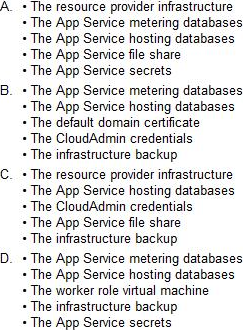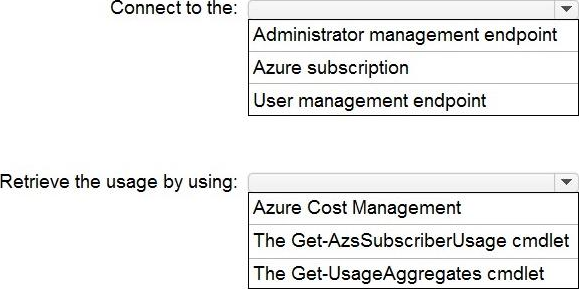Microsoft AZ-600 Configuring and Operating a Hybrid Cloud with Microsoft Azure Stack Hub Online Training
Microsoft AZ-600 Online Training
The questions for AZ-600 were last updated at Dec 13,2025.
- Exam Code: AZ-600
- Exam Name: Configuring and Operating a Hybrid Cloud with Microsoft Azure Stack Hub
- Certification Provider: Microsoft
- Latest update: Dec 13,2025
DRAG DROP
You need to change the int1 region to use the capacity model. The solution must meet the technical requirements.
Which three actions should you perform in sequence? To answer, move the appropriate actions from the list of actions to the answer area and arrange them in the correct order.

As part of the planned changes for the int1 region, you need to remove all the user subscriptions and the associated resources. The solution must meet the technical requirements.
Which two actions should you perform? Each correct answer presents part of the solution. NOTE: Each correct selection is worth one point.
- A . Run the Set-AzsuserSubscription cmdlet against to the administrator management endpoint.
- B . From the Azure portal, remove all the guest user accounts.
- C . From the administrator portal, delete all the user subscriptions.
- D . From the user portal delete all the resources in the user subscriptions.
You need to resolve the performance issue reported by the users in the priv1 region.
What should you do?
- A . Redeploy the virtual machines to a new Azure Stack Hub node
- B . Install the NVIDIA drivers on the virtual machines
- C . Install the AMD drivers on the virtual machines
- D . Add an additional scale unit node
You remove all the workloads from the int1 region and change the registration model to capacity.
You prepare additional Azure AD tenants for each partner.
You need to configure multitenancy.
Which two actions should you perform for each guest tenant? Each correct answer presents part of the solution. NOTE: Each correct selection is worth one point.
- A . Run the Register-AzSWithMyDirectoryTenant cmdlet and specify
https://management.int1.
northwind.com as the endpoint. - B . Run the Register-AzSGuestDirectoryTenant cmdlet and specify
https://management.int1.
northwind.com as the endpoint. - C . Run the Register-AzSGuestDirectoryTenant cmdlet and specify https:// adminmanagement.int1. northwind.com as the endpoint.
- D . Change the registration model to pay-as-you-use.
- E . Run the Register-AzSWithMyDirectoryTenant cmdlet and specify https://adminmanagement.int1. northwind.com as the endpoint.
You need to implement disaster recovery for the priv1 region to meet the technical requirements.
Which main components should you include in the disaster recovery plan?

- A . Option A
- B . Option B
- C . Option C
- D . Option D
You need to change the DNS forwarder of the priv1 region.
Which two actions should you perform? Each correct answer presents part of the solution? NOTE: Each correct selection is worth one point.
- A . Run the Register-CustomDnsServer cmdlet
- B . Run the Add-DnsServerForwarder cmdlet
- C . Run the Set-AzsDnsForwarder cmdlet
- D . Connect to the administrator management endpoint of the priv1 region
- E . Connect to privileged endpoint (PEP) of the priv1 region
HOTSPOT
You are troubleshooting the chargeback issues of the dev1 region.
You need to query the usage for each tenant subscription.
What should you do? To answer, select the appropriate options in the answer area. NOTE: Each correct selection is worth one point.

The priv2 region is redeployed according to the planned changes.
You need to restore App Service.
Which three components should you restore? Each correct answer presents part of the solution. NOTE: Each correct selection is worth one point.
- A . the App Service roles and services
- B . the file server share content
- C . the infrastructure backup
- D . the worker role virtual machine
- E . the App Service databases
- F . the default domain certificate
Topic 3, Trey Research
Case study
This is a case study. Case studies are not timed separately. You can use as much exam time as you would like to complete each case. However, there may be additional case studies and sections on this exam. You must manage your time to ensure that you are able to complete all questions included on this exam in the time provided.
To answer the questions included in a case study, you will need to reference information that is provided in the case study. Case studies might contain exhibits and other resources that provide more information about the scenario that is described in the case study. Each question is independent of the other questions in this case study.
At the end of this case study, a review screen will appear. This screen allows you to review your answers and to make changes before you move to the next section of the exam. After you begin a new section, you cannot return to this section.
To start the case study
To display the first question in this case study, click the Next button. Use the buttons in the left pane to explore the content of the case study before you answer the questions. Clicking these buttons displays information such as business requirements, existing environment, and problem statements. If the case study has an All Information tab, note that the information displayed is identical to the information displayed on the subsequent tabs. When you are ready to answer a question, click the Question button to return to the question.
Overview
General overview
Trey Research is a pharmaceutical company that has an office in Boston.
Existing environment
Identity Environment
The on-premises network contains an Active Directory forest named treyresearch.net. The forest contains a user named User1.
The forest syncs to an Azure AD tenant named treyresearch.net by using Azure AD Connect.
Trey Research has an internal certification authority (CA).
Compute Environment
The datacenter in the Boston office contains a computer named CLIENT1 that runs Windows 10. CLIENT1 is an administrative workstation that connects directly to the Azure
Stack Hub integrated system.
Planned changes and requirements
Planned changes
Trey Research identifies the following planned changes:
✑ Change the Azure Stack Hub integrated system registration to use an Azure subscription named Subscription3 that has a GUID of 12345678-1234-1234-1234-222222222222.
✑ Configure the integrated system to resolve external names by using a DNS Server that has an IP address of 10.100.100.100.
✑ Implement the App Service resource provider and the Event Hubs resource provider on the integrated system/
✑ Publish a custom cloud-init built image of a Linux virtual machine to Azure Stack Hub Marketplace on the integrated system.
✑ Create a new cloudadmin user named User2.
✑ Assign the delegated provider role to User1.
Azure Stack Hub Requirements
Trey Research identifies the following Azure Stack Hub requirements:
✑ Azure Stack Hub integrated system logs must be forwarded to an external security information and event management (SIEM) system named SIEM1. SIEM1 requires TCP with mutual authentication and TLS 1.2 encryption.
✑ A default Microsoft SQL Server instance will host the database of the App Service resource provider.
✑ The infrastructure of the integrated system must be backed up as frequently as possible.
✑ The integrated system backups must be retained for 28 days.
Business Requirements
Minimize software and licensing costs.
HOTSPOT
You need to configure the Azure Stack Hub infrastructure backups. The solution must meet the Azure Stack Hub requirements.
What should you do in the Azure Stack Hub administrator portal? To answer, select the appropriate options in the answer area. NOTE: Each correct selection is worth one point.

You need to configure the log forwarding. The solution must meet the Azure Stack Hub requirements.
What should you do?
- A . Connect to 192.168.101.101 and run the Set-EventLogLevel and Add-AzLogProfile cmdlets.
- B . Connect to 192.168.100.224 and run the Set-SyslogServer and Set-SyslogClient cmdlets.
- C . Connect to 192.168.100.224 and run the Set-EventLogLevel and Add-AzLogProfile cmdlets.
- D . Connect to 192.168.101.101 and run the Set-SyslogServer and Set-SyslogClient cmdlets.
Latest AZ-600 Dumps Valid Version with 73 Q&As
Latest And Valid Q&A | Instant Download | Once Fail, Full Refund




